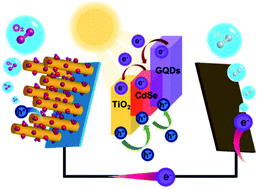Incorporating graphene quantum dots to enhance the photoactivity of CdSe-sensitized TiO2 nanorods for solar hydrogen production
Abstract
This work demonstrated that the incorporation of graphene quantum dots (GQDs) can greatly improve the photoelectrochemical (PEC) efficiency of CdSe-sensitized TiO2 nanorods (TiO2/CdSe), a TiO2-based visible light-responsive photoelectrode paradigm, for solar hydrogen production. For TiO2/CdSe, the accumulated holes at CdSe may induce photocorrosive oxidation to decompose CdSe, deteriorating the long-term stability of the photoelectrode and degrading the PEC performance. With the introduction of GQDs, the delocalized holes can further transfer from CdSe to the GQDs, which eases the hole accumulation at the CdSe sites, thus retarding photocorrosion. Compared to the binary TiO2/CdSe photoanode, the ternary TiO2/CdSe/GQD photoanode displays higher photocurrent and better photostability toward PEC hydrogen production. This superiority can be attributed to vectorial charge transfer and enhanced reaction kinetics provided by the introduction of GQDs. The findings from this work highlight the importance of the introduction of GQDs as a potential solution to the photocorrosion issue of chalcogenide-sensitized semiconductor photoelectrodes.



 Please wait while we load your content...
Please wait while we load your content...